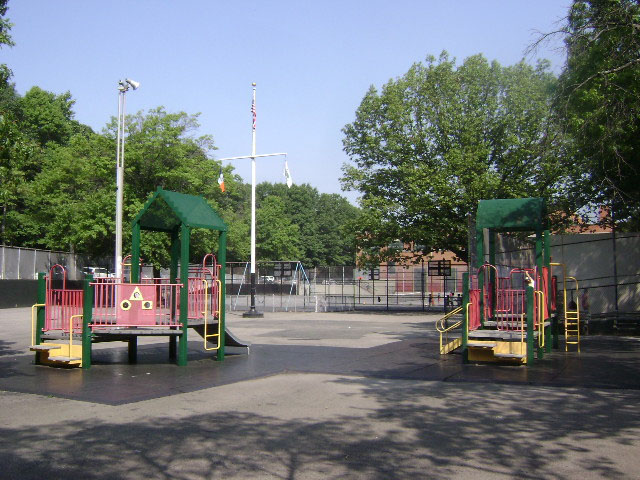
Seven-Gables-Playground
Place Category: Parks and Playgrounds
American author Nathaniel Hawthorne (1804-1864) is the namesake of nearby J.H.S. 74, so Parks named this playground after one of his best known books. Hawthorne published The House of the Seven Gables in 1851, just one year after The Scarlet Letter. The author notes in a short preface to the novel that it is “a romance.” Hawthorne wishes his readers to dispense with the constraints of realism so that he might employ the fantastic and the improbable to address abstract truths about human existence. The relationship between the past and the present is a central concern in Seven Gables as Hawthorne relates the unusual history of one house and its inhabitants.
In the novel, Colonel Pyncheon, the Puritan patriarch of the family, built the famous seven-gabled house on land that he acquired by persecuting its rightful owner on charges of witchcraft. After his execution, the innocent man allegedly left a curse upon Colonel and all the Pyncheons that were to inhabit the house. Strangely enough, the Colonel dies just a few years later under suspicious circumstances. The principal characters in the novel are the Colonel’s 19th century descendants who have become impoverished in the intervening centuries. They have taken in a boarder and opened a corner store in the house to survive. Though they struggle, a series of fortuitous events eventually rights all the wrongs supposedly set in motion by the Colonel. The Pyncheons inherit another estate and leave their cursed house. Moreover, the curse itself is demystified when the true cause of mysterious deaths in the family is revealed. The youngest woman in the family falls in love with their boarder, who happens to be the descendent of the man wrongly condemned by the Colonel so long ago, and their union restores his property.
Varying between about three and seven feet below the street level, this playground can be reached by ramps on either side. A fence flanked by two oaks separates the four basketball courts next to the school from the rest of the playground. There is a set of swings between the trees, while a flagpole with a yardarm marks the middle of the playground. Climbing equipment with safety surfacing provides separate play spaces for older and younger children, with another oak tree nearby. At the end of the playground is a set of toddler swings.
The site of this playground was originally attached to Cunningham Park. In 1944, Oceania Street opened and separated the two spaces. In 1952, the City built the school and playground on this side of the street. Although it is no longer physically connected, the playground is still part of Cunningham Park.
The site of Cunningham Park was first suggested on the map of Greater New York drafted in 1900. The map was created under the direction of Louis Risse, the chief engineer of New York City’s Topographical Bureau who designed the Grand Concourse in the Bronx, and it measured 27 by 31 feet. Displayed at the Paris Exposition, it was one of the most popular attractions, along with the Metro, Paris’s new subway, which opened four years before New York’s first line. The map proposed tying the newly merged boroughs together with new parks, boulevards, and highways. The City gradually acted on many of the proposals on Risse’s map, including the creation of a park on this site, buying parcels of land between 1928 and 1944.
Among the parcels that were merged to create Cunningham Park was the first automobile highway in the United States. Built in 1908 by William K. Vanderbilt Jr. as a toll road, its financial performance worsened as the public highway system grew. It finally closed in 1938, and has become a tree-lined path within the park. Walkers, joggers, and bicycle riders now use the former Motor Parkway. Despite the incorporation of this early highway, Cunningham Park was long cursed by the automobile. For over 30 years, the Departments of Sanitation and Transportation used a site on the east side of the park for vehicle parking. The curse was lifted in 1986, when the area was restored as playing fields.
- Seven Gables Playground
Queens
New York
11364
United States No Records Found
Sorry, no records were found. Please adjust your search criteria and try again.
Google Map Not Loaded
Sorry, unable to load Google Maps API.
-

